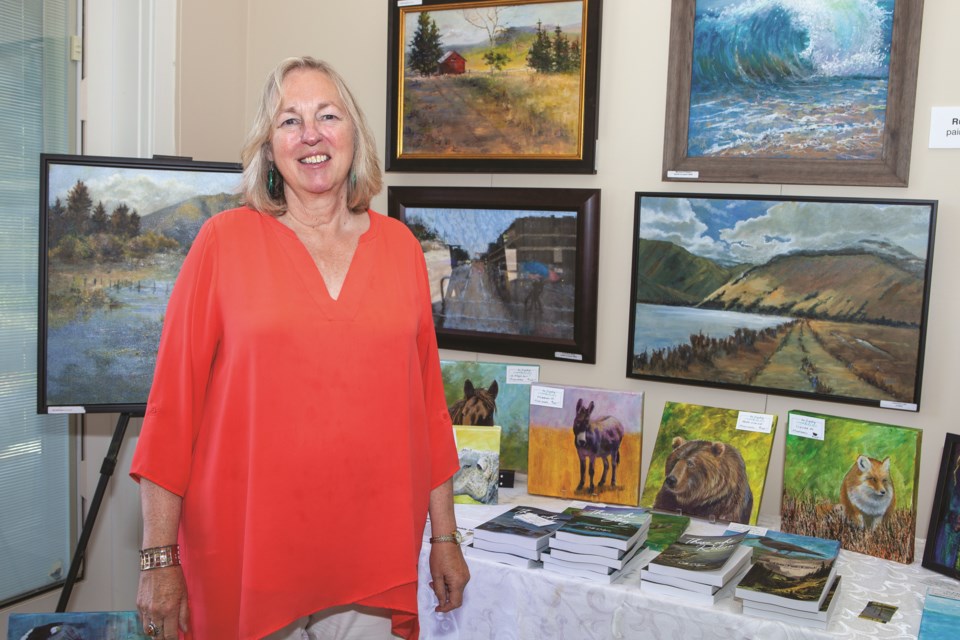A new work of historical fiction by a Halfmoon Bay artist and author transforms the traditional narrative arc into a prismatic array, illuminating parallels between the pioneering lives of women in Canadian journalism.
Ruth Rodgers launched Between the Lines, her seventh book, during the Art Crawl studio tour in October. Rodgers’s extensively-researched novels shine light on underrepresented chapters of Canadian history, including the challenges faced by female settlers in Canada (Those Who Wander) and multigenerational ruptures caused by the World War Two internment of Japanese-Canadians (Those Who Return).
In Between the Lines, Rodgers forgoes sequential storytelling in favour of parallel character studies. The book follows four founding members of the Canadian Women’s Press Club, which was established in 1904.
Robertine Barry wrote for the Montreal newspaper La Patrie and published an independent magazine, Le Journal de Françoise. Agnes Deans Cameron, an educator and lecturer, traveled further north in Canada than any White woman before her. Kathleen Coleman became the first Canadian female journalist to serve as a war correspondent, during the Spanish-American war in Cuba. Kate Simpson Hayes, who wrote for newspapers in Winnipeg and Saskatchewan, was the first woman journalist in Western Canada.
“It just one thing leading to another,” said Rodgers, whose interest was piqued after reading about Cameron’s journey to the Arctic Circle. “I thought, here’s another group of Canadians, and women in particular, whose names probably nobody even knows. And yet they did good work and laid the groundwork for some of our really good female journalists today. Their paths transformed our willingness to listen to female journalists talk about serious topics and expect more from them than just the foods and fashion and fads.”
Rodgers establishes the individual themes of each journalist’s life, carefully sketching Canadian moires in the late 19th century. (After trimming her hair to a practical length, one of Agnes Deans Cameron’s students wonders aloud, “Why is that man wearing a dress?” Even a member of the K’òmoks First Nation conjectures, “I think maybe she be two-spirited.”) Through unremitting diligence, each heroine strives for equitable status in the journalism world, and a measure of independence.
The disparate threads converge in St. Louis, Missouri in 1904. The four journalists form part of a delegation of 16 Canadian women who travelled by rail to provide newspaper coverage on the World’s Fair. The group became popularly known as the Sweet Sixteen.
“They were very sympathetic and they connected very well,” said Rodgers. “The women who proposed that they continue [the association] with the Canadian Women’s Press Club really hoped to maintain that closeness.”
One of the challenges for female journalists at the time was defying expectations of what women could write about — as gingerly as possible.
“They were always having to walk that very narrow path between saying and talking about the things they thought were really critical like women’s rights and equal pay for equal work,” said Rodgers. “They wanted to talk about those things. But they knew that if they did it too often or too stridently they would lose their voice. Their male editors would shut them down.” Kit Blake Coleman suffered that fate. Coleman was cut from the Mail and Empire newspaper in February 2011 without its editors providing any explanation to its readers.
Not all men stood in the way of progress. George Henry Ham, a publicist for the Canadian Pacific Railroad who facilitated the watershed Sweet Sixteen trip, is eulogized by Kate Simpson Hayes. Upon his death, she recalls one of Ham’s favourite expressions: “Unkindness is a worse crime than theft.”
The book’s denouement leaves readers with no easy victories. Real-life history, even elevated by Rodgers’s imagined dialogue, is overburdened by early mortality, antiquated prejudices, and professional squabbles.
“I feel that Canadians have had a slightly undeserved sense of superiority that we’re better than other cultures,” added Rodgers. “And we’re not. We have our own sordid history. Those are the stories I try and tell: we need to keep working at it to continue to get better.”
Between the Lines will be available for sale at Talewind Books in Sechelt and Earthfair in Madeira Park as well as online retailers.



